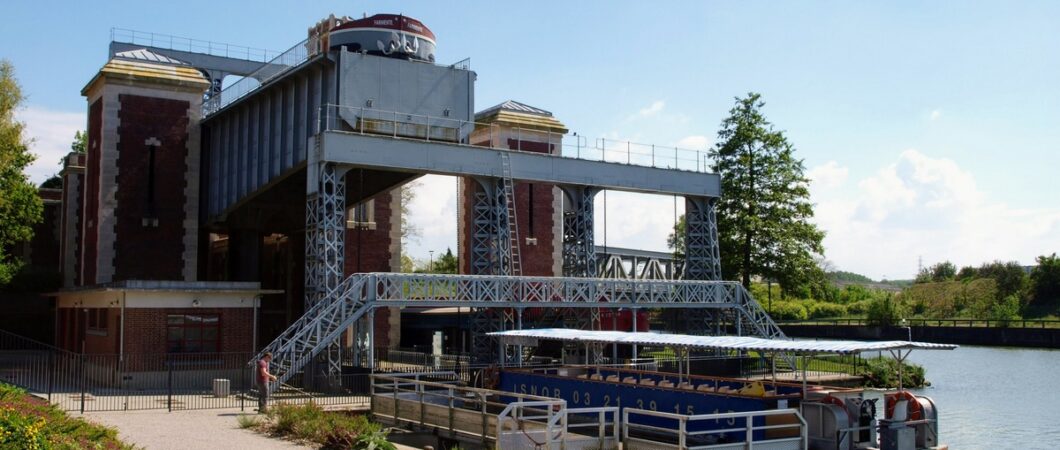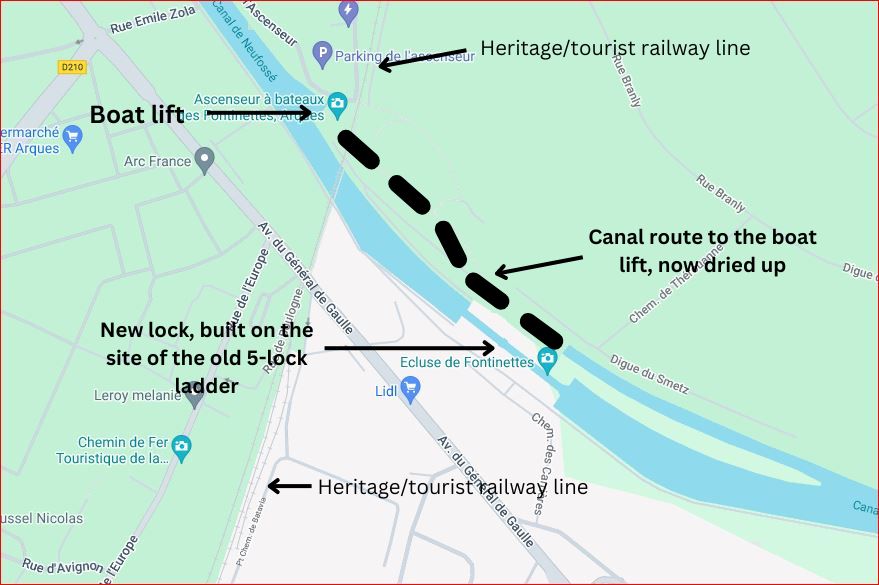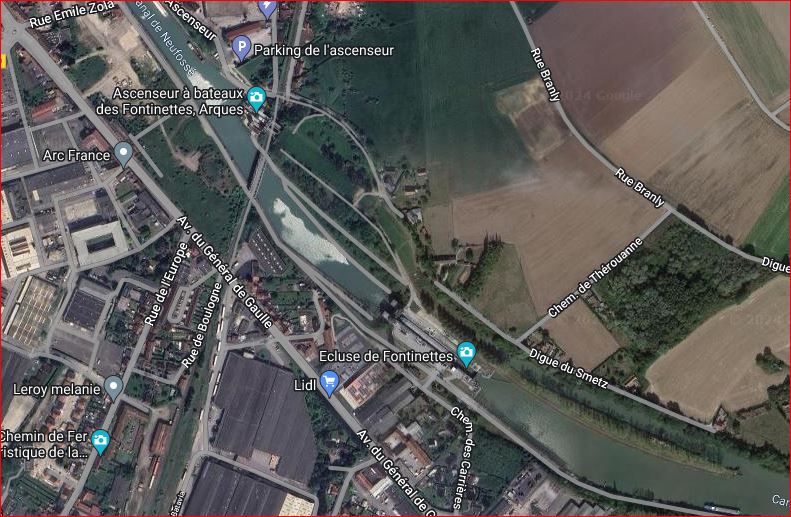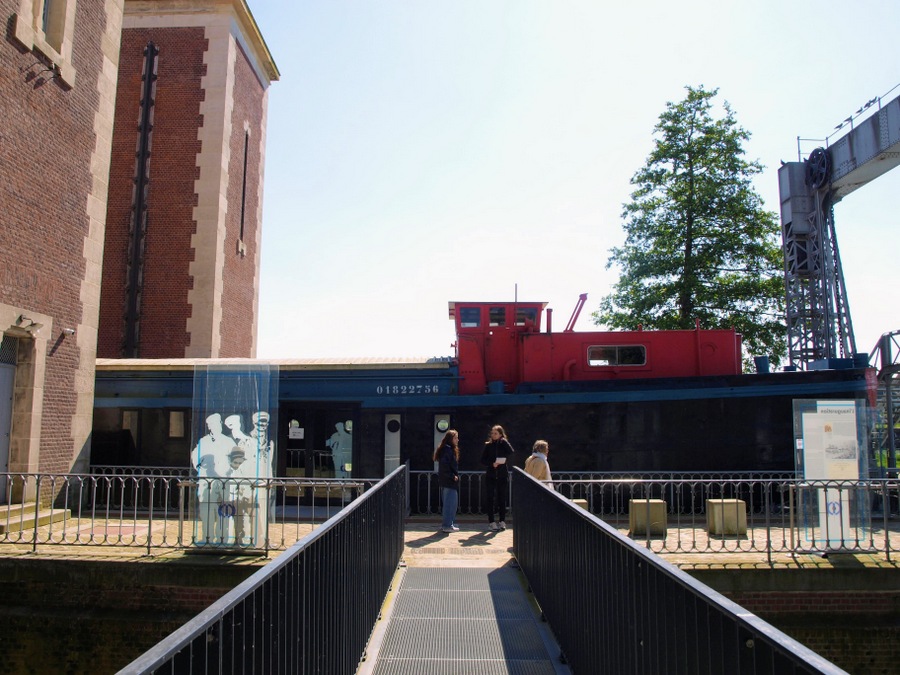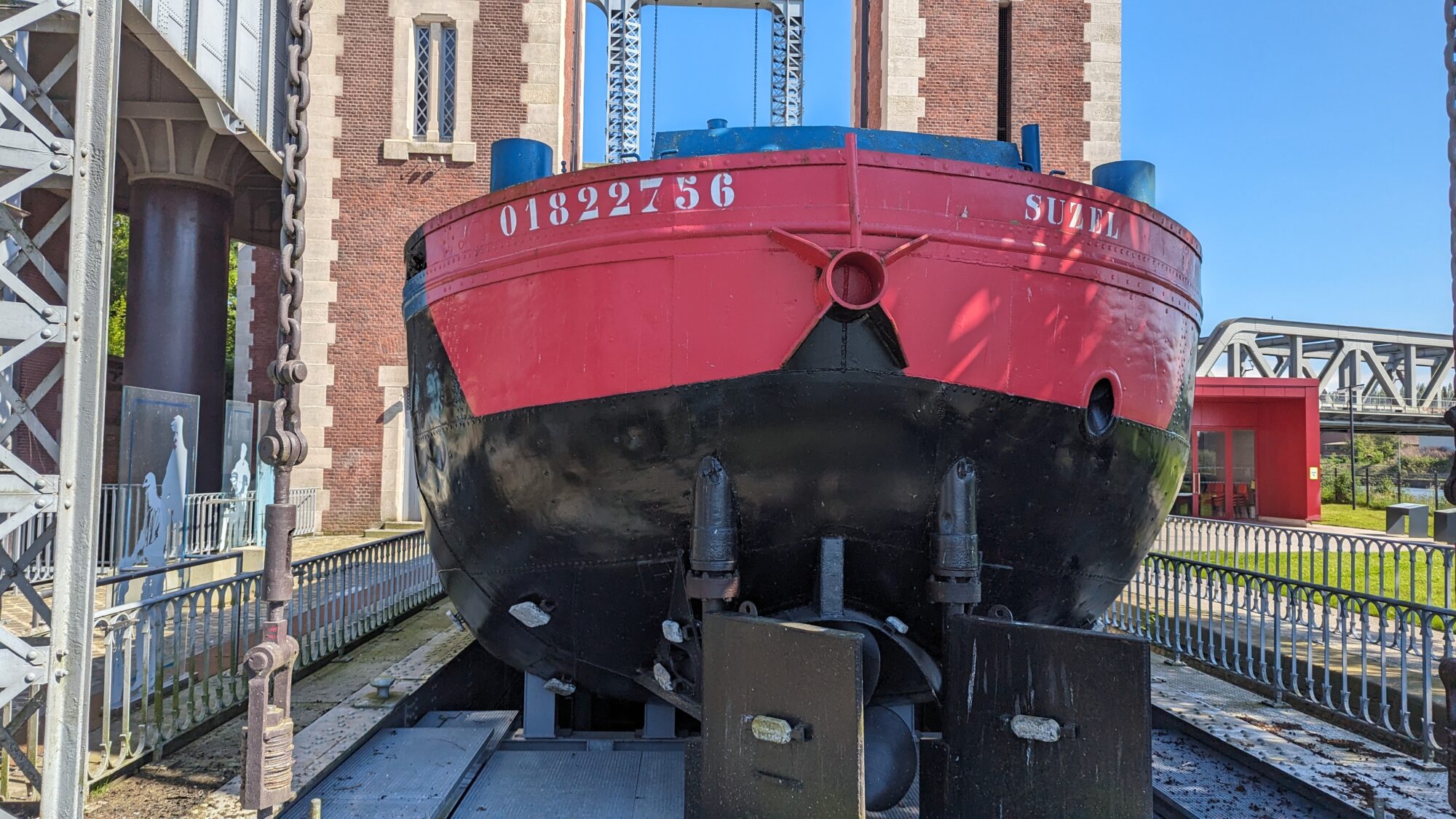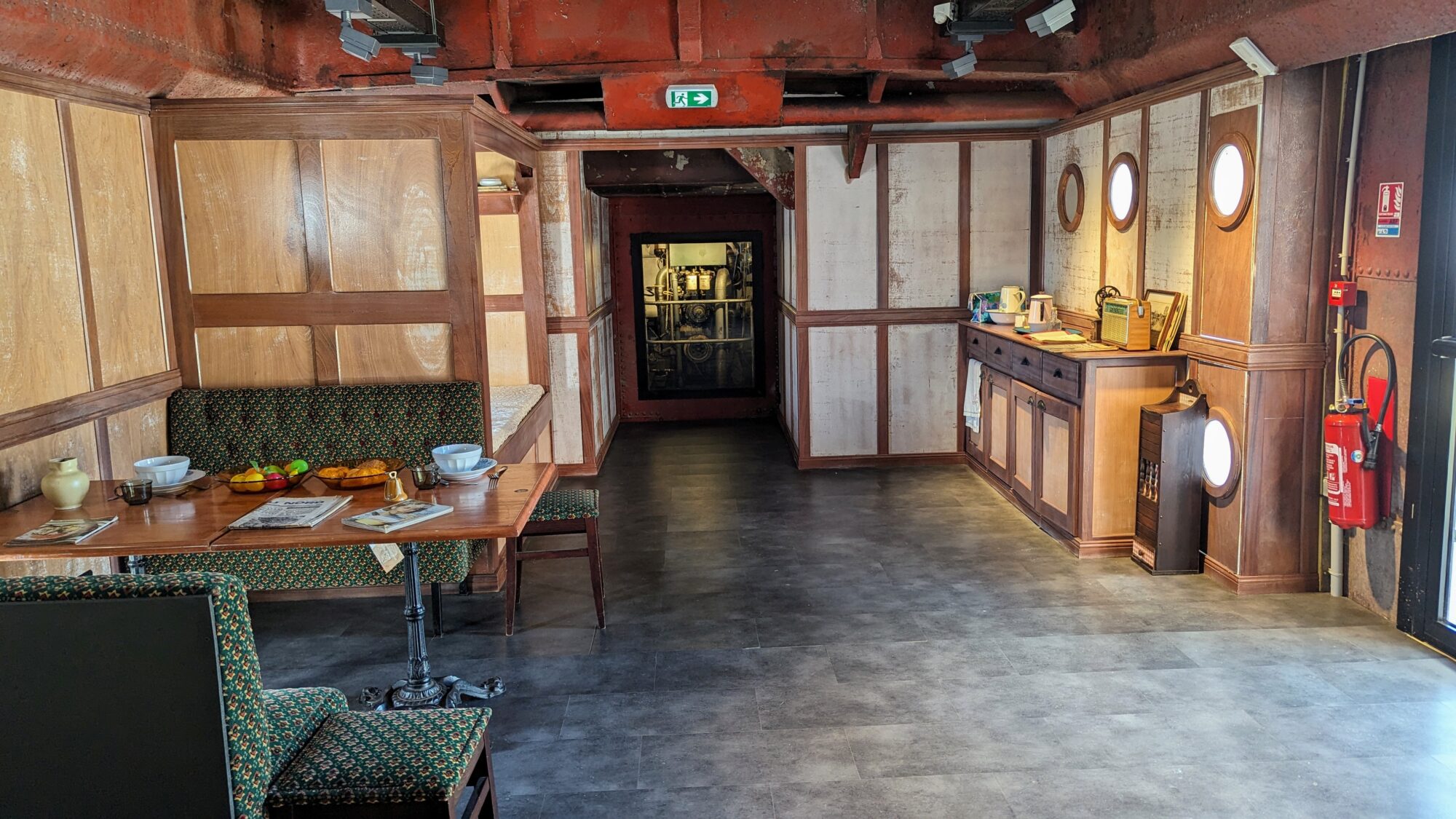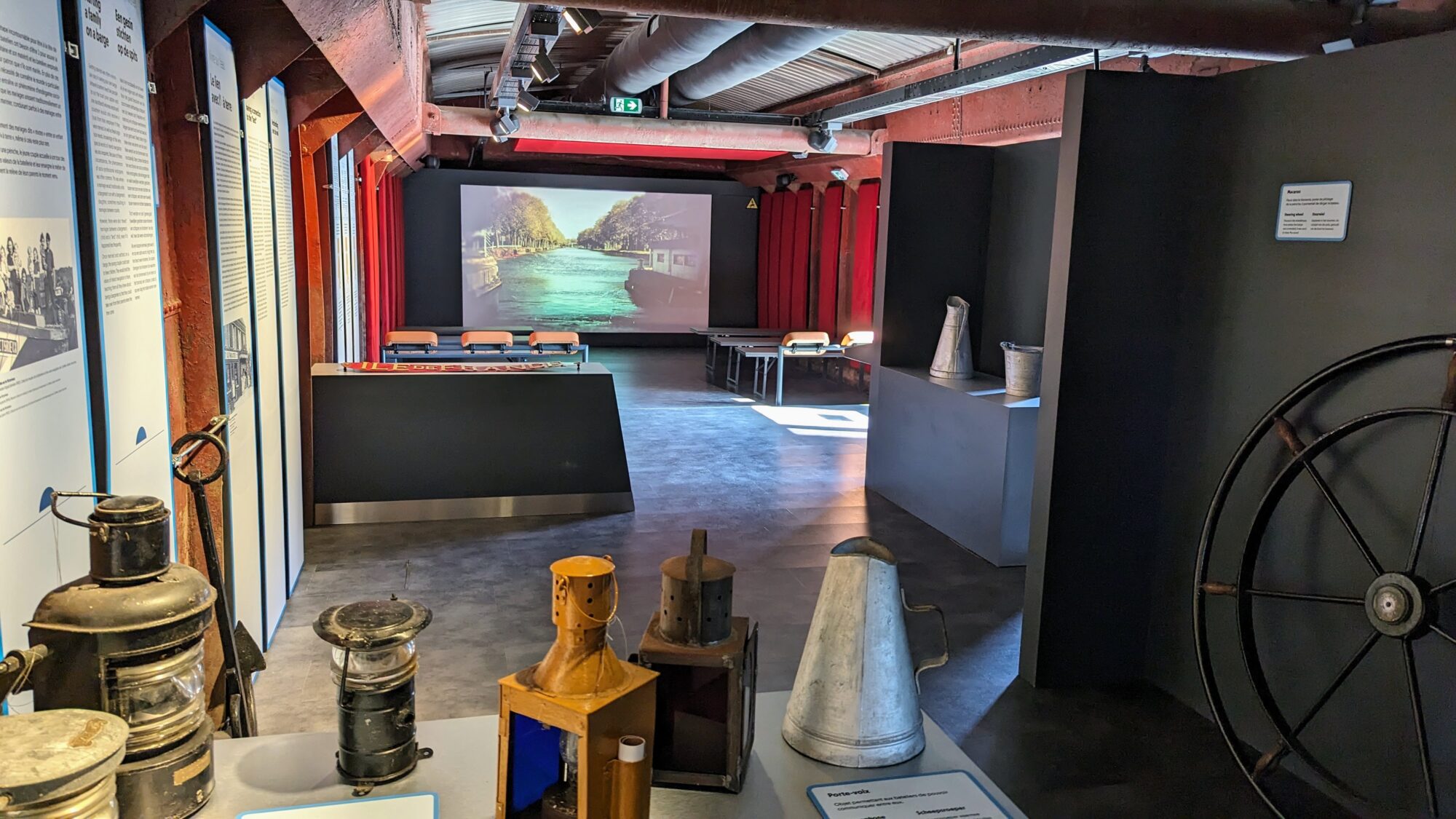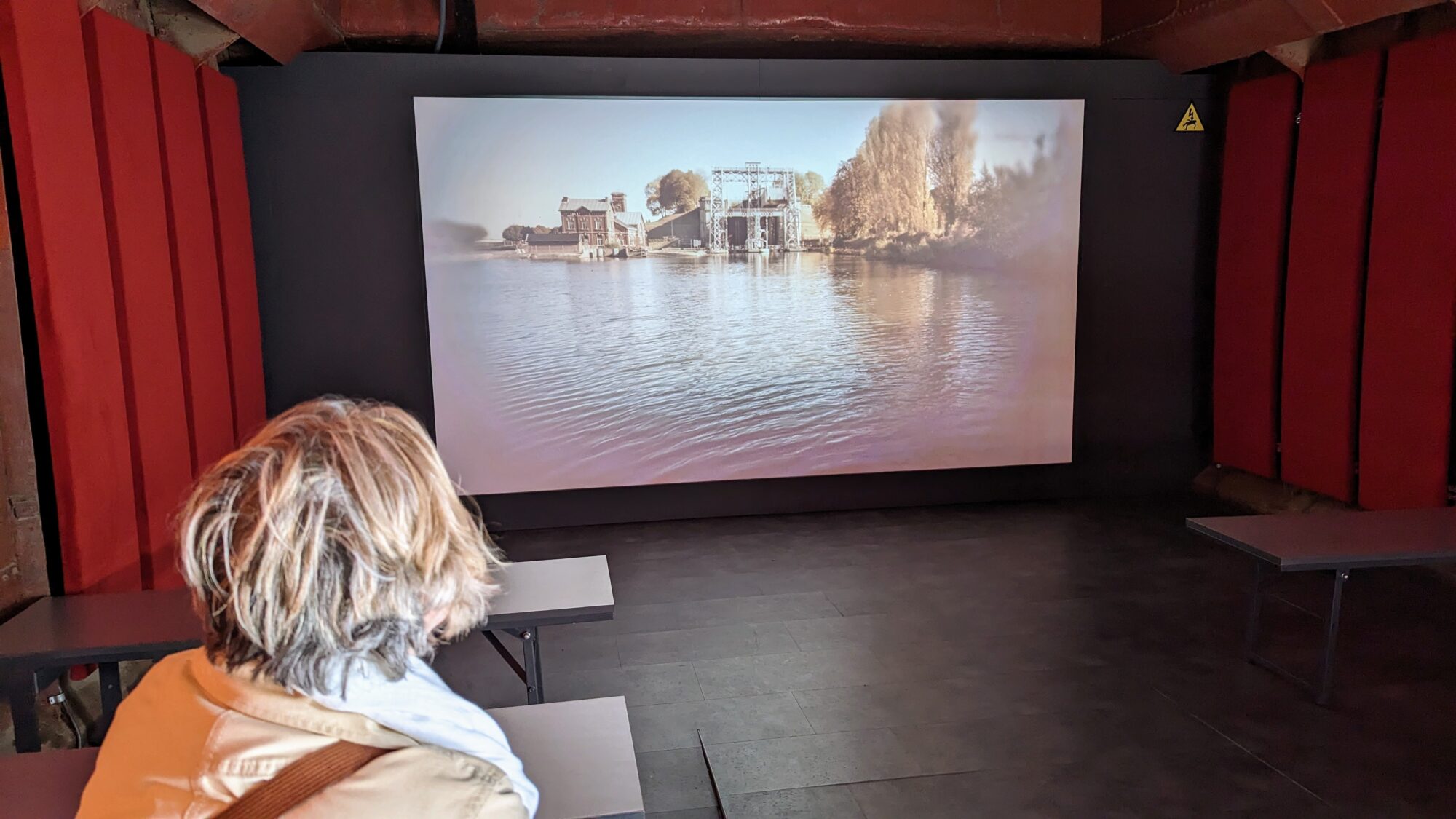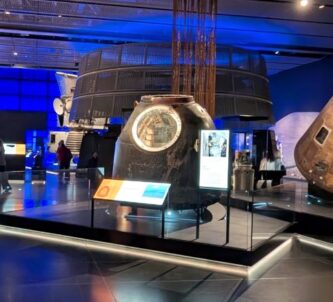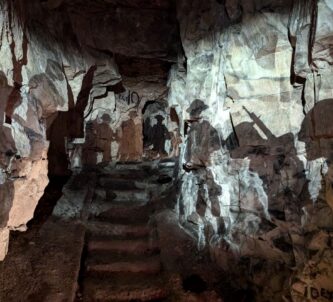The Fontinettes Boat Lift (Ascenseur à bateaux des Fontinettes) in Arques, Pas-de-Calais. is a magnificent piece of 19th century engineering and architecture.
It was built in the late 19th century at Fontinettes* to replace a set of five locks on the Neuffossé canal which linked/s the canalised rivers Lys and Aa**. This was an important trade route connecting Lille to the North Sea, and the busy traffic resulted in long queues at the 5-lock ladder. It could take days waiting to get through.
So, the thinking was, to replace the locks, which dropped/raised the canal barges over 13.3 metres, with a boat lift. This was high tech engineering, but the civic authorities in Arques took their inspiration from the Anderton Boat Lift (15.2m rise) in England which had been built just a few years earlier in 1875. In 1880 they hired its designer, Edwin Clark, to design a boat lift for them. Construction began on 18 August 1883, under the supervision of Auguste Bertin who was the Chief Engineer at the Ministry of Bridges and Highways, and was completed in 1887. It was opened in July 1888.
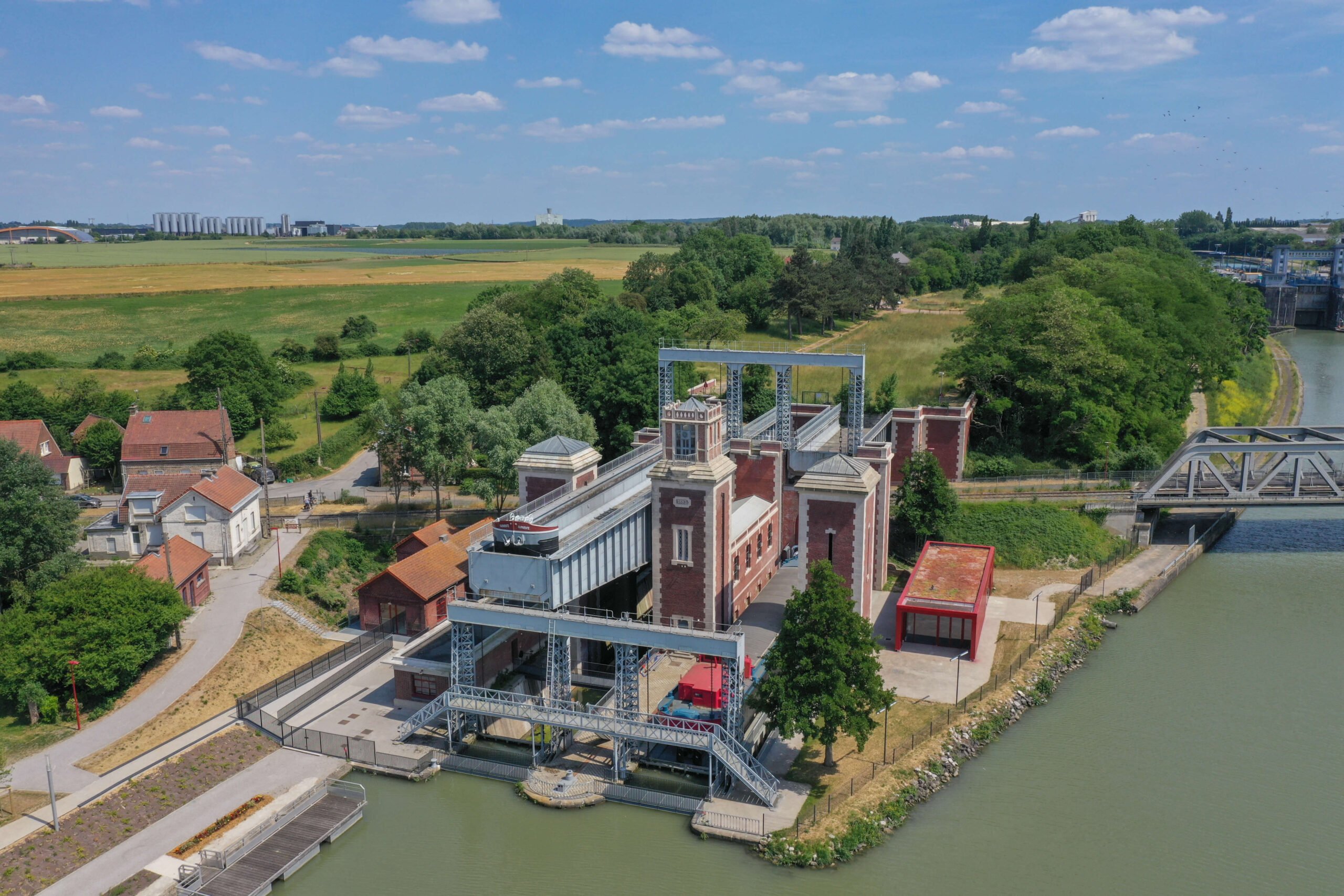
All this took place under the influence of the Freycinet Plan. Charles de Freycinet was the Minister of Public Works whose huge programme of public works on the canals and railways was voted through by the French senate in 1878 and made law in 1879. Its main purpose was to give every French citizen access to the railway, thus boosting national productivity and opening up rural areas. One of the results of the plan was the creation of the ‘Freycinet Gauge’ for standardising the size of barges at 38.5m long x 5.05m wide x 2m draught, which the new lift would have to accommodate. And another result was the requirement for a railway connection on the site.
How did the Fontinettes Boat Lift work?
It’s wonderfully simple. The two iron basins are supported on two massive hydraulic pistons. Each basin can carry one 350 tonne ‘Freycinet barge’, however the weight is irrelevant since each barge displaces its own weight in water. All that needs to be done is to add extra water to the upper basin and then, up in the control room on the middle tower, the operator opens the transfer valve between the two pistons and they start moving.

How much overload is needed in the upper basin? Well, when the rising basin reached the top of its travel, it stopped 30 cms short. This allowed an extra 64 tonnes of water into the basin, providing enough hydraulic pressure to lift its twin.
The whole boat lift could be operated by 6 men and each movement took 22 mins for the transition of two barges. Compared to 1hr 10mins descending and 1hr 35mins ascending for one barge through the ladder, this was a big improvement***.
Is the Fontinettes Boat Lift still working?
Sadly not.
somebody thought it would be prudent to fill the hydraulic cylinders with concrete!Officiating at the grand opening in 1888 was the Deputy of the Pas-de-Calais Department, Alexandre Ribot. Always with an eye on the future, he told the large crowd that the boat lift represented the cutting edge of modern civil engineering, but that at the rate that technology was currently advancing (it really was a period of rapid development), the chances were that in 100 years it might be replaced by something even more efficient. He wasn’t far out; the boat lift was operational for just 80 years before being replaced.
During that time, the old 5-lock ladder was kept as a back-up to cover for breakdowns and maintenance periods at the boat lift, but as Monsieur Ribot had predicted, by the 1960s canal engineering and barge sizes had moved on. The ladder was demolished in 1963, and in its place a single, large lock was built. The new ‘Fontinettes Lock’ can lower or lift up to six Freycinet barges the full 13.3m in 20 minutes. It opened in August 1967, leaving the Fontinettes Boat Lift high & dry.
Unfortunately, when the boat lift closed, the buildings were left to decay, the upper canal was filled in, and somebody thought it would be prudent to fill the hydraulic cylinders with concrete! So there is absolutely no chance of seeing it operate ever again.
The Fontinettes Boat Lift’s more recent history

After being left to rot for two decades and threatened with destruction, a group of locals formed an association in the 1980s to protect it, and it was finally granted the status of a National Monument in 2014. In 2017 it was closed to the public for a major renovation which was completed in the summer of 2023.
So, what’s there?
The recent renovation has cleaned up the whole site – no more mouldy or crumbling brickwork, no more rusty metal.
The basic route through the site takes you from the reception building into the workshop, where lathes and other machine tools were powered through overhead belts by a water turbine.
Passing across to the lower basin, there is a large barge, the Suzel, which has been converted into a museum focused on the lives of bargemen and their families. At the stern there is a recreation of a family room and at the bow there’s a small cinema showing what travel in the 60s was like for commercial bargemen. In between there are photo displays, information panels, and artefacts from old barges.
On the other side of the barge, on the canal bank, there’s a modern multi-purpose building (red on the aerial photo) used for exhibitions, schools and children’s workshops, and events.
Around the Fontinettes Boat Lift
You could make a day of it, visiting Arques. Facing the boat lift, on the opposite side of the canal, are two of France’s famous brands.
The ARC crystal glassworks were founded in 1825 and are home to the tableware sub-brands Luminarc, Arcopal, Cristal d’Arques Paris, Arcoroc and Chef&Sommelier, beloved of canteens, restaurants and event caterers the world over. ARC offers pre-booked 90-min factory tours.
Nearby is one of the region’s best known breweries, La Goudale. La Goudale (“good ale”) is a strong ale (7.2 ABV) of the type that has been brewed using local ingredients, since the 14th century. The brewery was founded in 1919 and has been in Arques since 2016. Goudale also offer brewery tours.
If you wanted to visit the Boat Lift and Arques by heritage (steam & diesel) railway, the Freycinet inspired railway that runs past the boat lift is now operated by Chemin de Fer Touristique de la Valée de l’Aa (CFTVA). Their track runs for 15 kilometres from Lumbres to Arques.
Update – 18/07/2025: I’ve discovered there is an operational hydraulic cylinder boat lift in Canada – the Kirkfield Lift Lock on the Trent-Severn waterway in Ontario.
* Les Fontinettes is the historic name of the location, now a part of Arques, which is both a town and a commune.
** The River Lys source is in Pas-de-Calais from where it flows 202 kms (126 mi) northeast to the river Scheldt at Ghent, Belgium. In Belgium it is called the ‘Leie’. The River Aa (“water” in Old Dutch) runs 93 kms (58 mi) from Bourthes in Pas-de-Calais to Gravelines on the coast.
*** Each lock in the ladder could take only one barge but they all had to be going the same way, so three days a week were designated ‘descending days’ and four days were ‘ascending days’… which is why it could take days to get through.
Declaration: I was on a self-driving press trip as a guest of Saint Omer/Pas-de-Calais Tourisme. Our guided tour was complementary.
Factbox
Website:
Ascenseur à Bateaux
Getting there: Ascenseur à Bateaux
Rue de l’ascenseur
62510 ARQUES
France
Easy to get to and plenty of parking.
Entry Price (2024):
| Standard visit | Guided visit | |
|---|---|---|
| Normal rate | € 5.90 | € 9.00 |
| Consessions* | € 4.90 | € 8.00 |
| Group visit (10+) per person | € 4.50 | € 8.00 |
* Children 4-15 yrs, students, seniors 60+. Children under 4 go free.
Opening Hours (2024):
| Apr, May, Jun & Sep | Wed, Fri, Sat, Sun. 2.00 – 6.00pm |
| Jul & Aug | All days. 10.00am – 1.00pm, 2.00pm – 6.00pm |
| Oct – Mar | Closed but group visits can be arranged |

